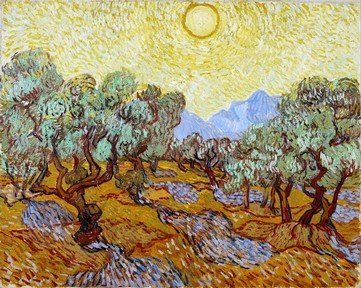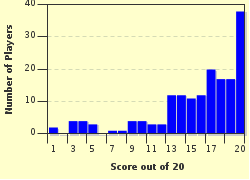Quiz Answer Key and Fun Facts
1. In 1427, the Italian painter Masaccio completed a fresco entitled "The Expulsion from the Garden of Eden". Does this fresco show any other character than Adam and Eve?
2. In one of the illustrious paintings by Rembrandt, we see a Persian king at his feast. Suddenly a hand appears from nowhere and writes down some Aramaic characters on the wall. Only the prophet Daniel can explain this extraordinary event: God gives a warning to the Persian King. This King was known by his Persian name Belshazzar (hence the title of the painting: "Belshazzar's Feast"). What did the mysterious hand write on the wall? (See Daniel 5:25)
3. Claus Sluter made a baptismal font that decorated the abbey of Champmol near Dijon. This font was named after the Old Testament person who dominates the second book of the Bible.
Which Old Testament figure has given his name to this sculpture?
4. Sir John Everett Millais created a painting dedicated to one of the few women who gave her name to a book in the Old Testament. This woman was appointed Queen by the Persian king Xerxes. When she discovered a plot against the Jews, she denounced Haman the conspirator. Haman was then hanged on the gallows he had erected for the Queen's uncle. Who was this Queen?
5. We all know that Christ multiplied the bread following the Sermon on the Mount. However, Christ was not the first to miraculously feed a great multitude with only a few breads. Which prophet did do so in the Old Testament? You can find this scene on a picture by Tintoretto.
6. Bronzino painted an event that probably is derived from actual history: archaeological findings do support the thesis that this scene from the Book of Exodus did really happen. However, scientists still debate how this would be possible. Which event is depicted in the painting by Bronzino?
7. Which Italian artist made the statue "Habakkuk and the Angel" in 1655? You can nowadays find this terracotta statue in the Vatican museum.
8. Giovanni Pisano has completed in 1297 a marble statue of a major prophet. The statue shows a bearded person, turning his head to behold the spectator. My favourite quote of the book named after this prophet is
"The wolf will live with the lamb,
the leopard will lie down with the goat,
the calf and the lion and the yearling together,
And a little child will lead them." (Chapter 11 verse 6 of the eponymous book, according to the New International Version).
As you have certainly guessed by the way I make reference to the aforesaid quote, I will ask now for the name of this major prophet. What is his name?
9. Luca Giordano made a painting of the moment Jacob fell in love with Rachel. Where did this happen?
10. Peter Paul Rubens made a painting depicting "Daniel in the Lion's Den". Why did the lion not harm Daniel?
11. Jean Fouquet illustrated in 1460 "The Book of Hours" for Etienne Chevalier. One of the illustrations shows us a nude man on a pile of manure, and three spectators who don't offer any assistance. Who is this nude man? His friends are identified as "The False Consolers".
12. Tintoretto's painting "Joseph and Potiphar's Wife" shows us a turning point in Joseph's life. What did she do to Joseph?
13. Andrea Mantegna completed in 1495 a painting which shows us a young woman putting a man's head in a servant's bag. The woman holds a metal blade with sharp edges (however, without a point, so it is not a classical sword). I'll give you the name of the victim: Holofernes, the leader of a Persian army, was beheaded by this woman. Who is the heroine depicted by Mantegna?
14. A famous German painter and etcher depicted Lot and his daughters fleeing Sodom. Genesis 19:15-26 describes how Lot, his wife and his two daughters flee from Sodom while a sulphuric rain destroys the city and all who dwellt there. Alas, Lot's wife looked back and was turned into a pillar of salt. Which German artist made a picture of this biblical scene in 1498?
15. Rosso Fiorentino painted a nude Moses involved in a fistfight with several other nude men. In the background, we can distinguish one shepherdess whom Moses defended. Who was the father of this shepherdess? The title of the painting gives us the answer.
16. This scene was the theme of a competition between Florentine sculptors and architects. It was one of the Old Testament scenes that nowadays decorate the East Door of the Florentine baptistery. The competition was won by Lorenzo Ghiberti, who made a total of ten scenes (among which this one) in gilded bronze. The scene displays a patriarch, his son and an angel in the right half, and a ram and two unidentified persons in the left half. What is this scene?
17. Rubens made, about 1609, a painting depicting a young woman caressing a sleeping nude man with an athletic appearance. The man has fallen asleep in her lap. A male servant touches the long curly hair of the man, and a company of soldiers is waiting in the background. What is the title of this painting?
18. One of the paintings in the Sistine Chapel in Rome represents "The Drunkenness of Noah". It shows us Noah fallen in sleep before a wine barrel. He is completely nude, and his sons are about to cover him (with a transparent veil). Who is the artist of this fresco? You may answer with only his first name, for his family name is not well known.
19. "I see, I see, what you cannot see." These could have been the words of Balaam's donkey. However, the donkey spoke other words. Balaam was going to curse the Hebrews, but his donkey refused to go any further, as it saw an angel in the way. Balaam didn't notice the angel until Balaam's donkey cried out: "What have I done to you to make you beat me these three times?" (Numbers 22:28, New International Version). What is this angel carrying? The whole scene was the subject of a painting by Rembrandt.
20. Pieter Brueghel the Elder has depicted thrice a building project named in the Old Testament. His first rendering of this building project is lost, but we'll discuss here the second one: a painting completed in 1563. It shows us a huge edifice while construction is still underway. The top of this edifice reaches to the clouds. Where did someone venture to try and build the only skyscraper mentioned in the Old Testament (more specifically in the Book of Genesis)?
Source: Author
JanIQ
This quiz was reviewed by FunTrivia editor
agony before going online.
Any errors found in FunTrivia content are routinely corrected through our feedback system.

